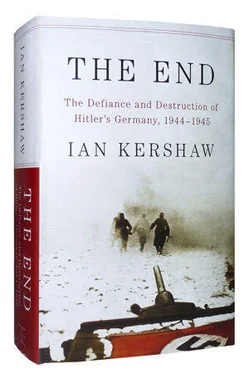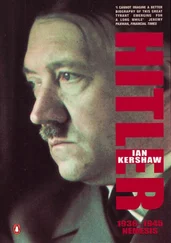peace negotiations: with Eisenhower 369, 370–71; with Montgomery 366–7, 369
Frisches Haff lagoon 173, 174, 178, 179, 180, 183, 251
Fromm, General Friedrich 35, 36
fuel supplies 93, 94, 131, 132, 165, 170, 252, 253
Allied bombing, effect on 79–80, 135
aviation fuel 135
Führerprinzip see leadership concept
Gardelegen, massacre of concentration camp prisoners at (April 1945) 333
Gauleiter (provincial/regional governors) 11, 13, 22, 25, 40, 64, 65–6, 84, 89–90, 111, 118, 125, 138, 142–4, 163, 182, 185, 216, 256, 278–9, 287, 296, 399
central control of 77, 78, 81, 83, 88
in the final phase (March/April 1945) 316–17, 318–21, 342–4, 392
Hitler and 244–5, 318, 320
local troops recruited by 85–6
power held by 392
as Reich Defence Commissars (RVKs) 22, 41–2, 43, 88, 89, 101, 102, 103, 224–5, 290–91
Speer and 290–91
suicide among (post-April 1945) 356
see also individual Gauleiter
Gebhardt, Karl 62, 113
Gehlen, Colonel Reinhard 170
Geisler, Hermann 243, 294
Geneva Convention, Hitler considers scrapping of 259
Gerland, Karl (Gauleiter of Kurhessen) 319
German Army
armaments for see armaments
casualties see casualty figures
civilian population’s hostility towards 261, 262
compulsory military service/conscription 71, 100, 138
courts martial 205, 212, 219–20, 252, 263, 390–91
deserters 155, 196, 211, 212, 218–20, 243, 259–60, 262–4, 272, 297, 305, 313, 314–15, 342, numbers of 220, 390, 391; under a white flag 320; see also execution of below
disintegration of 68, 211, 218–20, 314–15, 367–8
on eastern front 368–71; troop numbers 368; see also Red Army
evacuation 66–7, 68, 177; from eastern front 372–5
execution, of deserters/disaffected troops 69, 120, 155, 203, 204, 216–17, 219, 220, 243, 262, 263, 320, 360–61, 390, 391
Guderian as Chief of General Staff 45–6, 48, 49, 85–6, 102, 106, 127, 165, 170–71, 197–200, 205, 252, 253, 256, 259, 284, 288; dismissal 251–2, 284, 305–6; see also leadership below
Himmler’s reorganization of 36–8
Hitler, allegiance to 32–4, 44–5, 71, 153–4; decline in 66, 212; on his death 248–9
Hitler as C-in-C 169–72, 201, 202, 395–6, 398
Hungarian troops in 93
in Italy 165, 254, 256, 266–7, 284–5; troop numbers 364
Krebs as Chief of General Staff 252, 306, 308; see also leadership below
leadership 11, 12, 33–4, 36–7, 44–6, 48–52, 53, 154, 169, 171, 196–206, 211–12, 218, 263–73, 296, 302–10, 340, 394–5; criticism of 64–5, 44–7, 68, 70; disaffection among 220–21; generals, number of 266; numbers killed 394; OKH 169–70, 197, 198, 199–200; surrender by 297, 300–301, 304, 368, 369, 373, 376; see also Guderian above; individual officers; Krebs above ; Wehrmacht High Command
looting by 212, 259, 315, 342
militia see militia units
morale see morale
mutiny among 259; viewed as impossible 272–3
Nazi Party’s unpopularity with 214, 261, 312
new divisions planned (1944) see Replacement Army
organizational structure 250, 253
rear echelon ( Etappe ) 67–8, 81
refugees, treatment of 201–2
troops numbers 132, 165, 168, 170, 174, 206, 247, 250, 251, 252, 253, 255, 256, 266, 285, 301, 308–9, 310, 353; in Berlin 308–9; on eastern front 368; in Italy 364; in Norway 367
troops, quality/standard of 137–8, 247, 253, 255, 270, 301, 307, 308, 310–11
Volksgrenadier divisions 64, 151, 222–3
Volkssturm see Volkssturm
Women’s Battalions 310
see also individual units; Waffen-SS; Wehrmacht
German Army atrocities 98, 107, 112
German capitulation (May 1945) 6, 11–12, 14–15, 18, 348–85
Act of Military Surrender (7 May 1945) 371; Soviet version (8 May 1945) 371–2; events following 371–9
Allied demands 370–71; see also Allied strategy, unconditional surrender . . .
Dönitz’s peace negotiations 351, 354–5, 362, 366–77; for partial capitulation 351, 362, 376; von Ribbentrop on 361
Eisenhower, negotiations with 368, 369, 370–71, 375, 376
German-controlled areas at time of 366–7; map 365
in Italy 267, 285–6, 363, 364, 366
Montgomery, negotiations with 366–7
post-war trials 328; at Nuremberg 354
German Navy 205, 265
Dönitz as C-in-C 39, 48, 169, 204, 264, 265, 306, 308, 395
evacuation of civilians by 179, 265, 367, 368, 372
von Friedeburg as C-in-C 360
morale 265, 360–61
transfers from, to Wehrmacht 206, 265, 267, 308, 353, 372
welfare provision in 265
German prisoners of war 32, 56, 70, 71, 154, 160, 196, 211, 226, 254, 255, 260–61, 267–9, 270, 306, 315, 369
in Australia 306
in Soviet hands 94, 254, 368, 369, 371; from Army Group Centre 375; deaths among 375
German Red Cross 183, 192
German–Soviet Treaty of Friendship (September 1939) 99
Germany
administration see administrative systems; Gauleiter
border provinces 72, 85, 86; see also East Prussia
civilians see civilian population
collapse of 207–25, 240–46, 247–92; maps showing 248 , 249
radicalization of 51–3
as a totalitarian regime 8–10, 84, 207–8
war aims/objectives 37
see also Hitler, Adolf; Nazi Party
Germany (pre-war) 8, 13, 98, 208, 384
see also First World War
Germany, occupation of (1945–on) 7, 12, 71, 379–85
Allied-appointed mayors 279
as a legal state 378
reconstruction phase 377
by Soviet Union 379
Yalta Conference communiqué on 246
Gerngroß, Captain Rupprecht 343
Gestapo 149, 208
foreign workers, persecution/execution of 227–8, 328
Giesler, Paul (Gauleiter of Munich-Upper Bavaria) 214, 344
Glogau 204
Goebbels, Joseph (Minister of Propaganda) 11, 22, 23–4, 35, 63–4, 67, 90, 114–16, 118, 119, 159, 279, 315, 316, 358, 391
Bormann and 43, 317, 352; attempts to negotiate with Allies 352
character/personal appearance 23, 77, 146, 164, 243–4, 336, 337
his diaries 146–7, 149, 151, 160–61, 337
Dresden bombing, propaganda based on 238–9
family 243, 282; his murder of 337, 346
on Göring 243–4
Guderian and 46
Hitler and 147, 243, 244, 281–2, 336, 337, 399
negotiated peace, support for 280–82, 352
as Reich Plenipotentiary for Total War 38–41, 42, 49, 52–3, 73, 75–9, 86, 95, 104, 121, 142, 146–7, 241–4, 256–7, 259, 269, 279, 280, 295, 392, 396; administrative systems under 40–41, 75–9, 146, 241–2
on von Ribbentrop 243–4, 282
Soviet Union, suggests separate peace with 95–6
Speer and 24, 25, 43, 75, 76–9, 83, 146, 244, 287–8
suicide 337, 346, 352, 355
Goebbels, Magda (wife of Joseph Goebbels) 243, 282
suicide 337, 346, 355
Goldap 110, 111, 173
Göring, Hermann 20, 90, 163, 166, 205
Berlin, escape from 336
Bormann and 340
Goebbels on 243–4
as Hitler’s designated successor 20, 339, 340, 353, 397, 399
as Luftwaffe C-in-C 20, 39, 44, 48, 150, 160, 163, 169, 205, 306, 308, 342; dismissal (April 1945) 340, 342, 353, 399
negotiated peace, support for 280–81
post-war interrogation 30, 336
under house arrest (April 1945) 340, 342
suicide (October 1946) 356
Gotenhafen (Gdynia) 183, 234, 250
Gotha 297
Göttingen 297, 349
Gräser, General Fritz-Hubert 301
Great Britain see Britain
Читать дальше












